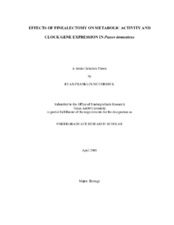| dc.description.abstract | The biological clock and the biological rhythms it controls are anticipatory mechanisms found ubiquitously across a wide variety of taxa, ranging from prokaryotes to eukaryotes, from bacteria to animals. Avian species, especially passerine species, rely heavily on melatonin input from the pineal gland, and this experiment further explores the role the pineal gland plays in the organization of the house sparrow clock. The uptake of 14C-labeled 2-deoxyglucose and clock gene transcription were observed in pinealectomized house sparrow brain and peripheral tissue to discern more about the role of the pineal gland in the neuroendocrine loop and its control over peripheral oscillators. Additionally, preliminary in vitro studies in chick astrocytes suggest two differentially regulated oscillatory mechanisms at the cellular level: a metabolic clock that rapidly responds to melatonin and a transcriptional clock that likely responds to the entrainment of the metabolic clock. Here we examine the metabolic and transcriptional impacts of pinealectomy in Passer domesticus to further explore the mechanics of the neuroendocrine loop in the brain, examine how pinealectomy impacts peripheral oscillators, and determine if cells are indeed controlled by two coupled oscillatory mechanisms. To this end, we utilized activity-monitoring equipment to measure locomotor activity; 2DG uptake was measured via autoradiography and scintillation counts in the brain and peripheral tissues, respectively; and clock gene transcription was measured via in situ hybridization and real time q-PCR in the brain and peripheral tissues, respectively. We hypothesize that, due to the coupled dual cellular oscillators and the lag between the metabolic and transcriptional clock, rhythms of 2DG uptake in peripheral tissue will damp prior to the transcriptional rhythm of the clock genes Cry1 and Per2. Lastly, the SCN’s metabolic and transcriptional oscillations will damp, without the pineal gland coupled to it. The results obtained thus far imply that rhythmic 2DG uptake in peripheral tissues of pinealectomized sparrows damps by day 3 in constant darkness, prior to locomotor arrhythmia, and that transcriptional rhythmicity damps in unison with locomotor rhythmicity by day 10. The data to date support the concept of two differentially regulated oscillators at the cellular level, at least within the heart. | en |


